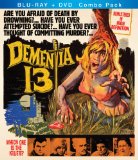In 1972 he made us an offer we couldn’t refuse. A couple of years later he followed it up with one of the finest sequels in Hollywood’s history. Of course, I’m talking about Francis Ford Coppola. His movies are often considered epics. When Coppola paints, he tends to paint big. But it wasn’t always like that for the once young director. He learned his trade, oddly enough, from the master of the B movie, Roger Corman. It was there that he learned to do more with less. It was there under the tutelage of Corman that Coppola and Jack Hill gave us one of the most atmospheric films to come out of the B movie machine: Dementia 13. It was another one of Corman’s attempts to squeeze everything he could out of his resources. Coppola was working, mostly as a sound designer, on Corman’s The Wild Racers. He offered Coppola the remaining resources to crank out one of his quick specials. Coppola put together a quick script that was intended to capitalize on the Psycho craze of the time. The result was a creepy film that might have been better than the feature the funds came from, at least horror fans think so.
Louise (Haloran) is arguing with her husband in a row boat when he has an inconvenient heart attack and dies. The inconvenience for him is quite obvious. For Louise it means she won’t be getting her hands on any of his family’s money when Mother (Dunne) finally kicks the bucket. So Louise develops a quick plan. She dumps hubby in the lake and arranges things so it looks like he had to leave suddenly for business in New York. Meanwhile, she’ll stay with his family at their castle and estate in Ireland. But, things don’t go as planned. The family is still mourning the death of Kathleen (Dowling) many years ago in a drowning incident. Each year they have a private little ceremony, and the event has shaped their very existence at Castle Haloran. There’s also someone with an axe to grind, preferably in the heads of unlucky victims. Good old family Dr. Caleb (Magee) plays detective and has the pond where Kathleen died drained, revealing an even deeper mystery. Who killed Kathleen and now members of the Haloran clan and anyone else unlucky enough to be in the wrong place at the wrong time?
The movie stars William Campbell, who recently passed away at age 87. Star Trek fans will remember him as Trelane, the Q predecessor and as Klingon Captain Koloth in the famous episode The Trouble With Tribbles. He plays one of the Haloran brothers here along with Bart Patton as the other brother. The movie makes excellent use of the leftover Irish locations and creates wonderful atmosphere that has kept it somewhat of a cult favorite over the years.
It’s not a great film, but you can see the beginnings of Coppola’s style, particularly camera angles and lighting. When you consider the time in which this film was cranked out from script to final product, it’s quite impressive. Add the very effective music of Corman staple Ronald Stein and you have something that was never intended to stand the test of time…but did.
Video
Dementia 13 is presented in an aspect ratio of 1.78:1. The original was a slightly less wide 1.66:1. The 1080p image is arrived at with an AVC MPEG-4 codec at an average 30 mbps. There are many problems with the video. It might have been taken from a 35 mm print but not the master print. The public domain versions of the film are not from that source material. So, the restoration here is a bit of a stretch. There is evidence of perhaps too much processing so that the end result has both good and bad results. The print has been cleaned up so that there aren’t so many scratches and artifacts. But the print has lost much of its grain, and the contrast is really bad here. Whites are often washed out, while black levels get lost in a murky darkness. It’s still better than anything out there, by far. Just understand you’re getting a film that has problems that can’t be fixed with the source material available to the public domain.
Audio
The Dolby Digital Audio 5.1 is rather undynamic as well. You can hear the dialog fine, and Stein’s score is reproduced without any distortion. But it’s flat, and the studio opted not to include an uncompressed track.
Special Features
Just a trailer and restoration demo.
DVD Copy included.
Final Thoughts:
The film has fallen into public domain over the years and has propped up in many VHS and DVD releases. Unfortunately, most of them were from very bad prints and almost always appeared in a full frame format. For the first time we get to see the film in high definition and a widescreen presentation. It’s a real treat, one that should cause us all to ditch those crappy copies we’ve had for years and finally give this film an honorable place in our collections. “Welcome change, I’d say.”





